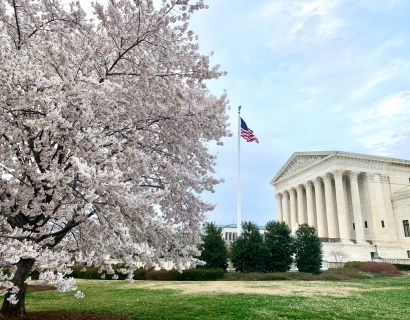Everything for  Business
Business
 Business
Business
 Business
Business
In the U.S. Supreme Court, dominated by an ambitious conservative wing, Chief Justice John Roberts has become an "island man." The 67-year-old chief justice, appointed in 2005 by Republican President George W. Bush, is a conservative try

In the U.S. Supreme Court, dominated by an ambitious conservative wing, Chief Justice John Roberts has become an "island man."
The 67-year-old chief justice, appointed in 2005 by Republican President George W. Bush, is a conservative trying to chart a gradual course for a court that would prefer giant leaps.
In a landmark abortion ordinance released Friday, Roberts tried to find a middle ground. He expressed his own opinion, joining the Conservative majority in support of mississippi's 15-week abortion law, but siding with three liberal court justices in opposing the majority's decision to overturn Rowe v. Wade.
This isn't the first time Roberts has taken a stance that conflicts with his fellow conservatives. He sided with liberal arguments in dissenting opinions on texas' abortion law in September, Alabama's congressional district in February and an environmental case in April. He has been targeted by angry conservatives who say he is not fighting hard enough to promote his views.
On abortion, Roberts "failed to control the direction of the trial," said David Gans, a civil rights attorney at the progressive Center for Constitutional Accountability. "There is a huge daylight between his position and that of the majority."
Roberts, a staunch defender of the court's institutional legitimacy, has historically sought gradual changes in constitutional law over time, rather than big shifts at once, and the abortion case was no different.
In a separate opinion Friday, Roberts said he would support the restriction after 15 weeks of pregnancy — the same as the Mississippi Law, which the court considered — instead of abandoning Rowe entirely, as the Conservative majority had done. In overturning the 1973 benchmark Roe v. Wade's decision, the court left it up to the states to decide whether and when abortion is legal.
"Both the opinion of the court and the disagreement demonstrate an unrelenting freedom from doubt on a legal issue that I cannot share," Roberts wrote. "I'm not sure, for example, that a ban on abortion from the moment of conception should be treated under the Constitution in the same way as a ban after fifteen weeks."
No other justice has joined his opinion.
The weakening of Roberts' influence coincided with abrupt changes in the composition of the court. Former President Donald Trump appointed three conservative judges and spoke loudly about choosing only those candidates who would vote to overthrow Rowe. First there was Neil Gorsach, and then there was Brett Kavanaugh, who replaced Anthony Kennedy, who sided with liberals on matters of same-sex marriage and, for the most part, abortion.
Just weeks before the 2020 election, Trump's third pick, Amy Coney Barrett, gave the wing a solid 6-3 majority, which reduced Roberts' influence.
"With a 6-3 majority, he still has a lot of influence, but he's no longer a swing voter on many issues," said Ilya Somin, a law professor at George Mason University.
Conservative judges also used their influence, increasingly satisfying emergency requests, which critics called a "shadow list." Liberal supporters adopted the term to criticize Supreme Court decisions that occur without a full-blown briefing and argument.
When a conservative majority emerged, Roberts found his way to dissent, joining liberal votes in September when a court upheld a Texas law banning most abortions after six weeks of pregnancy. In his comments at the time, Roberts did not go as far as liberal judges to say the law was unconstitutional.
In February, he joined liberal judges in disagreeing when a court restored Alabama's map of Congress and blocked a ruling that would have required a second heavily black district for the November election. In April, he joined liberals in another disagreement as the court temporarily reinstated a rule that reduced federal protections for streams, wetlands and other bodies of water.
Before the composition of the court changed, Roberts could more easily exert his influence. In 2012, he sided with liberal justices to become a decisive voice in support of Obamacare, a landmark achievement for then-President Barack Obama.
Former Vice President Mike Pence said in 2020 that Roberts "was a disappointment to conservatives" after decisions, including one that year, to invalidate abortions under Louisiana law.
"The big difference is that because he's not the fifth voice, his ability to get other people to go along with him is drastically reduced," said Jonathan Adler, a law professor at Case Western Reserve University.
Roberts has tried to maintain public confidence in the court, but it's been harder lately. There have been reports of schisms in court, as well as allegations of a conflict of interest for conservative Clarence Thomas. His wife, Ginny, a conservative activist, was involved in trying to discredit the results of the 2020 election, which Trump lost.
Even before the abortion ruling and Thursday's other decision expanding gun rights, Americans' confidence in the Supreme Court has reached a new low, according to a Gallup poll measuring faith in institutions for more than 50 years. The 11-point drop for the nation's highest court is about double the decline experienced by other agencies included in the survey.
In his solo opinion on Friday, before tens of thousands of protesters filled the streets of American cities in protest, Roberts wrote that he would "leave another day, whether it is worth rejecting any abortion right at all."
Roberts called for "judicial restraint," warning that reversing precedents would be a "major boost to the legal system."
 What are you doing with your RV in the offseason?
What are you doing with your RV in the offseason?
 Adobe will buy online design startup Figma for $ 20 billion
Adobe will buy online design startup Figma for $ 20 billion
 To combat the gas crisis, Germany offers a new plan for cheap transit
To combat the gas crisis, Germany offers a new plan for cheap transit
 Porsche family seeks iPO buyout after tearful defeat
Porsche family seeks iPO buyout after tearful defeat
 Clubs and bars are popping up all over Manhattan, providing an alternative social hub and jobs.
Clubs and bars are popping up all over Manhattan, providing an alternative social hub and jobs.
This site uses cookies and other visitor identifiers for the convenience of each user. If you stay on our site after reading this message, it means that you have no objection to the use of these technologies. Learn more
